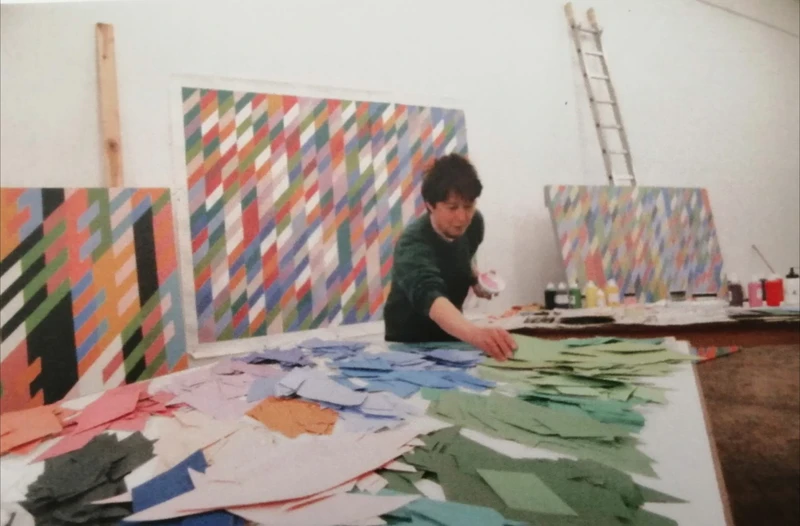Bridget Riley


b. 1931, United Kingdom
Bridget Riley's (b. 1931) abstract compositions yield a singular sense of visual pleasure for the viewer, a notion derived as much from the artist's formative encounters with Old Master and Impressionist painting as from her early experiences with nature. Since 1961, she has focused exclusively on seemingly simple geometric forms, such as lines, circles, curves, and squares, arrayed across a surface—whether a canvas, a wall, or paper—according to an internal logic. The resulting compositions actively engage the viewer, at times triggering sensations of vibration and movement. This sense of dynamism was explored to great effect in the artist's earliest black-and-white paintings, which established the basis of her enduring formal vocabulary. In 1967, Riley introduced color into her work, thus expanding the perceptual and optical possibilities of her compositions.
Riley was born in 1931 in London, where she attended Goldsmiths College from 1949 to 1952 and the Royal College of Art from 1952 to 1955.
Riley’s first solo exhibitions were held at Gallery One, London, in 1962 and 1963, followed by two exhibitions at Robert Fraser Gallery, London, in 1966 and 1967. She was also at that time included in numerous group exhibitions such as Towards Art?, Royal College of Art London (1962); The New Generation, Whitechapel Gallery, London (1964); and Painting and Sculpture of a Decade 1954–1964, Tate Gallery, London (1964). In 1965, her work was included in the now-seminal group exhibition The Responsive Eye, organized by William Seitz at The Museum of Modern Art, New York. In 1968, she represented Great Britain at the 34th Venice Biennale (along with Philip King), where she was the first living British painter to win the prestigious International Prize for Painting. Her first retrospective, covering the period from 1961 to 1970, opened at the Kunstverein Hannover in 1971 and subsequently traveled to Kunsthalle Bern; Kunsthalle Düsseldorf; Galleria Civica d’Arte Moderna, Turin; and the Hayward Gallery, London.
More recent significant solo presentations include those at Dia Center for the Arts, New York (2000-2001); Museum Haus Esters and Kaiser Wilhelm Museum, Krefeld, Germany (2002); Museum of Contemporary Art, Sydney (2004-2005); Musée d'Art Moderne de la Ville de Paris (2008); Walker Art Gallery, Liverpool (traveled to Birmingham Museums and Art Gallery; Norwich Castle Museum and Art Gallery; Southampton City Art Gallery; 2009-2010); The National Gallery, London (2010-2011); Art Institute of Chicago (2014-2015); The Courtauld Gallery, London (2015); De La Warr Pavilion, Bexhill on Sea, England (traveled to Gemeentemuseum, The Hague; 2015); Graves Gallery, Museum Sheffield, England (2016); Christchurch Art Gallery, New Zealand (2017); and Kawamura Memorial DIC Museum of Art, Sakura, Japan (2018).
A large-scale wall painting by Riley entitled Messengers was unveiled in 2019 at The National Gallery in London. Also in 2019, a solo presentation of the artist’s work that was organized by the National Galleries of Scotland opened at the Scottish National Gallery, Edinburgh, and traveled to the Hayward Gallery, London (2019-2020).
In 1974, Riley was named a CBE (Commander of the Most Excellent Order of the British Empire) and in 1999, appointed the Companion of Honour. In 2003, the artist was awarded the Praemium Imperiale in Tokyo. She received the Kaiser Ring of the City of Goslar, Germany, in 2009 and the Rubens Prize of the City of Siegen, Germany, in 2012.
Work by the artist is included in museum and public collections worldwide, including The Albright-Knox Art Gallery, Buffalo, New York; Art Institute of Chicago; Arts Council, U.K.; British Council, U.K.; Dallas Museum of Art; Dia Art Foundation, New York; Israel Museum, Jerusalem; Kunstmuseum Bern; Los Angeles County Museum of Art; The Metropolitan Museum of Art, New York; Moderna Museet, Stockholm; Museum für Gegenwartskunst, Siegen, Germany; The Museum of Contemporary Art, Los Angeles; The Museum of Modern Art, New York; National Museum of Modern Art, Tokyo; Nationalgalerie, Berlin; Stedelijk Museum, Amsterdam; and Tate, London.
[Biography supplied by David Zwirner]